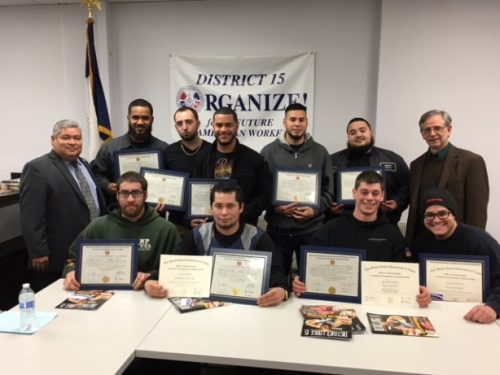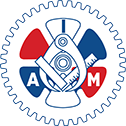
Nine Automotive and Diesel apprentices from the Youth Transition To Work Program in New Jersey, receive their journeyperson certificates.
For well over 100 years, apprenticeship training has been the oldest and most traditional method of on-the-job training in many of the industries where the IAMAW represents the workers in the United States and Canada.
The IAMAW concurs with our membership that there is still a need for the traditional craftsperson, particularly in industries that have upgraded their technology on the shop floor in an effort to meet the new challenges of a global economy. Collectively we believe that world class production and service depends on world class skilled workers. The traditional approach in the IAMAW is to work with employers to develop apprenticeships. However, while language exists, in many cases it is not being utilized. Yet, we believe the apprenticeship system of training meets all the needs of the evolving economy.
The IAMAW Executive Council, Business Representatives, staff and members of the will continue to support and encourage apprenticeship training with all employers who have collective bargaining agreements with the IAMAW. It is a recognized policy of the IAMAW that apprenticeship and training programs in which the IAM participates will not only be of the highest technical standards, but will also be open to any worker regardless of race, creed, color, religion, disability, sex or national origin.
OVERVIEW
Apprenticeship is a means of opportunity for workers to learn the skills of his or her occupation through productive work and related technical education as well as a means for employers to obtain a competent and highly skilled worker. The training of apprentices has always consisted of systematic instruction and experience in all the practical facets of work in a skilled occupation as an inexperienced worker enters a particular industry. The precision machining, aerospace, woodworking, manufacturing, transportation and health care industries all have occupations with a variety of needs in terms of professional knowledge as well as technical and mechanical skills.
By the very nature of the specific technologies and skill levels of these industries, they need workers who have the ability to learn quickly, have a natural aptitude for using tools and precision equipment and a desire to obtain the highest level of technical aptitude. It is, therefore, expected that in these industries a high degree of personal responsibility will be exerted by the apprentice. Even with supervision and guidance, the apprentices will find they are constantly in situations where their decisions and actions must result in a high quality product, improved productivity and safe working procedures. The Apprenticeship model has been proven to be the most successful training system in the world, producing the most highly skilled and qualified workers in industry, and the collective bargaining agreement and the Joint Apprenticeship Training Committee are the two vehicles best suited for preserving and maintaining the apprenticeship and training system.
GENERAL POLICY
While many employers are implementing training programs in their plants to meet the skill requirements of advanced technology. Other employers are not helping maintain or advance the skills needed in their facilities. Given that variety and breadth of skills and trades, apprenticeship training is varied and sometimes inadequate.
The International Association of Machinists and Aerospace Workers is resolved to establish a uniform apprenticeship and training system. Training by the adoption of IAMAW apprenticeship standards is intended to protect the future of industries, the union and the apprentice and to propose a comprehensive apprenticeship system whereby future apprentices will be carefully selected and properly trained in all of the mechanical and theoretical aspects of the industry.
It is also intended to be a system in which all apprentices who apply themselves will be insured the opportunity of becoming highly skilled journeypersons. While emphasis on specific work processes may vary from local-to-local or area-to-area, the standards have been formulated so that apprenticeship activities within the jurisdictional area of this program can be carried out in an orderly and efficient manner throughout the United States and Canada.
The Apprenticeship Department provides services and support for both current and future apprenticeship programs. The department’s activities involve tracking school-to-work programs, developing new apprenticeship opportunities, working with Locals and Districts on broader apprenticeship programs and endorsing actions by the Department of Labor to increase apprenticeship opportunities and prepare our members and future members for the skilled work of the future.
POLICY MANUAL
The IAMAW has developed an apprenticeship manual to make certain that extreme care is exercised in the selection of apprentices and that the methods of training are uniform and sound.
The intent is also, to assure that apprentices will be equipped for gainful employment and provide the labor market with the highest possible quality journeyman or journeywoman that relate to the future supply of journeypersons to probable employment demands.
This manual is intended to be a guideline and should be the minimum standard for apprenticeship and training programs developed by locals or district lodges of the IAMAW and employers who wish to administer such programs through Joint Apprenticeship Committees. To order a manual, contact the IAMAW Apprenticeship Department.
The Apprenticeship Department continues to provide the above services and support for the existing apprenticeship programs in place today, which has sharply declined since the early 1980”s. The department’s recent activities involve tracking the school-to-work programs and following the proposals which establish voluntary skill standards. With the ongoing technological changes in the workplace, skills needed yesterday may not be sufficient for tomorrow. Because of this, it is essential that we stay abreast of those changes to better prepare our members for the future.





